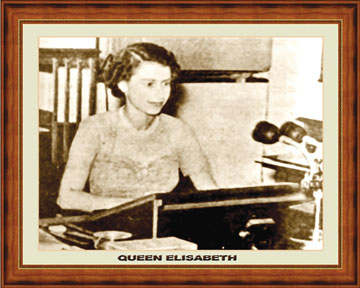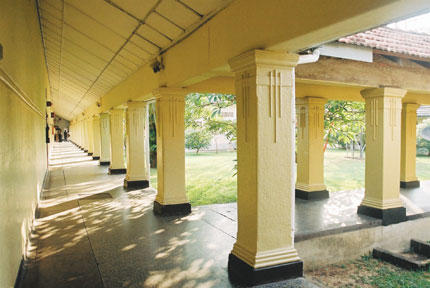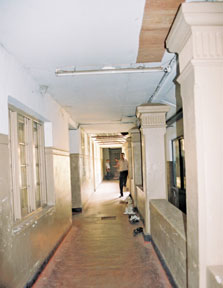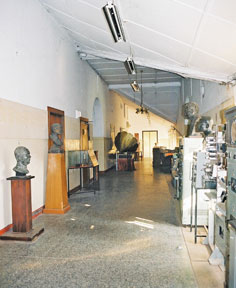The ‘haunted’ past of Radio Ceylon
by Chamari SENANAYAKE
Walking into the Sri Lanka Broadcasting Corporation (SLBC) buildings
at Torrington Square, one would immediately feel the historical value of
the place, but most people would not know just how valuable it is. Our
SLBC is Asia's first broadcasting corporation. Radio Ceylon started in
Sri Lanka then Ceylon, paving the way for many other radio stations that
later came to be celebrated around the world, inspiring countries such
as Hong Kong, Korea, India and Singapore to enter the world of wireless
media.
 DG of SLBC Samantha Weliweriya said that there was even speculation
that the SLBC is the world's second radio station. Even if such
speculation is not true, he said it is an indication of the importance
of Radio Ceylon in the world arena. Radio Ceylon definitely becomes the
30th station in the world, in a line dominated by mostly American and
British radio stations, bringing immense pride to Sri Lanka. DG of SLBC Samantha Weliweriya said that there was even speculation
that the SLBC is the world's second radio station. Even if such
speculation is not true, he said it is an indication of the importance
of Radio Ceylon in the world arena. Radio Ceylon definitely becomes the
30th station in the world, in a line dominated by mostly American and
British radio stations, bringing immense pride to Sri Lanka.
And that's not all, there is a hidden past behind the place now
occupied by the radio station. According to Chairman Hudson
Samarasinghe, who joined the SLBC many decades ago, and has been there
ever since, the area was used as a runway during World War II.
The racecourse next to Radio Ceylon was used by the military and some
parts of the Radio Ceylon grounds were frequently used for aviation
activities which made it difficult to carry out broadcasting functions.
Another interesting historical fact is that Radio Ceylon's broadcasting
activities were taken over by Allied Forces during World War II and when
the war was over, it was handed back to the government.
History began with the arrival of Edward Harper during the time of
Sir William Henry Manning. He was the chief engineer of the Telegraph
Department and soon began working on wireless broadcasts. The very first
experimental broadcast hit the airwaves as early as 1923. Not many
people know this fact and believe that the first experimental broadcast
was actually made in 1924, but the world had heard us a year earlier
from the Telegraph Department, just three years after the inauguration
of broadcasting in Europe. Harper and his assistants had broadcast
gramophone music as an experiment using radio equipment from a captured
German submarine.
Broadcasting heights
The actual launch of Radio Ceylon was in December 1925 by Sir Hugh
Clifford. The station came into being after the war and reached
broadcasting heights in South Asia, leading the way in the world of
entertainment and news. The very first senior management officers of the
station came from the British Broadcasting Corporation (BBC). They
worked tirelessly to make Radio Ceylon world-recognised, and it indeed
was then.
 |
|
These corridors which
still stand may have seen many trolleys carrying patients |
They even did a live coverage of the moon landing and used to cover
all major cricket matches before Rupavahini launched its live sports
telecasts. Talking about his Western inspirations and knowledge, Salman
Rushdie had once said, "I have to express my deep gratitude to what was
then called Radio Ceylon. It had a slightly more open attitude and did
play Western music, so that's where I became familiar with all kinds of
things that I could slightly regret, like the complete works of Ricky
Nelson."
Going back to the hidden and interesting past behind the place now
known as SLBC, one could not help but mention the word 'haunted'. The
old buildings there are over 150 years old and once was home to a
lunatic asylum. Standing proud and beautiful even today are the straight
and long corridors created especially for the use of a hospital. These
corridors have seen many old-fashioned trolleys, mobile beds and other
hospital equipment being pushed along by attendants and nurses.
They create a labyrinth inside the institution and even the people
most familiar with the place could easily get lost. Some say that staff
that work in the evenings and nights have heard peculiar sounds in the
dark and isolated corners. Although these are mostly hearsay and
speculation, the history behind the place is quite fascinating and could
create credible grounds for such stories.
Asylum proper
The Colombo Lunatic Asylum was the first mental hospital in Sri Lanka
and was built on the grounds that are now used by the SLBC. Most of its
records run as far as 1850, but the very first buildings could have been
built many years or decades before that.
 |
|
Surrounded by old studios, some of the
oldest corridors of the hospital are still in use |
It was divided into the asylum proper and the house of observation.
Usually, about 700 patients were treated each year at the beginning of
the 1900s. Even during the 19th century, in any given year, the number
of patients treated always stood above 500.
There was one recorded escape in 1905, but the escapee was later
found and brought back. Around the same time there was one attempted
suicide. During the first decade of the 20th century, a separate dining
hall for females and a dispensary were built. Work on a new mental
lunatic asylum began in 1920 at Angoda.
From the beginning, the Colombo Lunatic Asylum was overcrowded and
the accommodation provided was inadequate. It was the only mental
facility in the country and the superintendent could not turn people
away and had to take all patients that came in.
The mortality rate was high and remained above 50 each year. Almost
all deaths were due to TB and some were due to malaria. Over 300,000
people are believed to have died of malaria around the 1930s in Sri
Lanka.
Torrington Square, Colombo 7, Colombo 5 and the surrounding areas
were bushland then, and were known as Kumbi Kele (ant forest) and the
asylum grounds were quite large. Therefore, a corner of the land was
also used as the hospital's cemetery for bodies that were not claimed by
families.
The hospital had a large mortuary; this room is still there but
remains closed. Berty Galahitiyawa, a veteran announcer joined the SLBC
in 1962, and retired as Director-Training. He recalls the cafeteria in
the '60s which was near the mortuary, and some of his friends talking
about hearing strange sounds emanating from it while they were having
their tea breaks during the evening's broadcast. “We did not believe it,
but we knew there was a closed-down mortuary adjacent to the cafeteria.
Later on, many studios were built around it” he said.
Eerily silent
Ironically, there is a cafeteria there even today.
 |
|
Silent and dark rooms contain
memorabilia and equipment from Radio Ceylon's history |
Frederick Fiebig was originally an artiste and lithographer in
Calcutta in the 1840s. When he visited Sri Lanka in 1852 he had taken a
black and white picture of the SLBC which was later hand-coloured.
Even today, its long corridors are eerily silent with memories of the
past, not merely because of the way it was built for patient transport.
There are framed photographs of legends in broadcasting and other
important figures that were associated with the place. Sunil Shantha,
Rukmani Devi, Ananda Samarakoon and Premakeerthi de Alwis are some of
those who are no more .
In 1954, when Queen Elizabeth II visited Sri Lanka, a Radio Ceylon
van equipped with a disc-cutting machine was sent along with her to
record the important events.
An interesting fact about Radio Ceylon is that after conquering Mount
Everest, Edmond Hillary and Tenzing Norgay turned on their transistor
radio and the first thing they heard was an overseas broadcast on the
English All Asia service of Radio Ceylon.
The place now known as SLBC, most fondly remembered as 'Radio Ceylon'
is a legend of its own with a colourful, eerie and romantic past.
|

